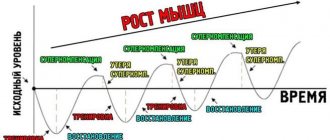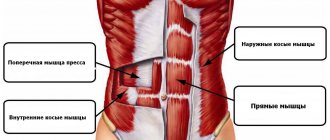Not all people can stick to diets or change their diet. To cleanse the body of toxins and accumulated harmful substances that come from food, and also to restore the body to a feeling of lightness, many resort to fasting. It can last for a different amount of time. Is it possible to combine dry fasting and sports? Isn't it dangerous for the body to practice fasting and running at the same time? You should familiarize yourself with the answers to these questions in advance.
What is cyclic fasting as a way to lose weight?
The key idea behind intermittent fasting is to reduce your total calorie intake, which ideally leads to weight loss. Typically, CG involves eating little or nothing for 16 to 24 hours (no more than 25 percent of your normal caloric intake). After the restrictive phase, you return to your normal eating pattern for 4-24 hours, depending on the version of the CG you follow. This is a simple example of how to lose weight through fasting.
https://youtu.be/l02fEf_a7mI
Basic schemes
There are two types of intermittent food restriction system:
- Short-term - fasting time does not exceed 24 hours. Breakfast is skipped followed by eating for 6 or 8 hours until a new window on a new day (simplified scheme - 10 or 12 hours).
- Long-term (eat-stop-eat) – suitable for those who do not go to the gym.
Scheme 14/10 or 12/12
Suitable for those who are trying to stick to a diet for the first time or if they lack confidence in their own abilities:
- 14 hours fasting and 10 hours eating;
- dividing the day in half.
Scheme 16/8 Martin Berkhahn
When intermittent fasting is practiced, 16/8 - 8 hours are allotted for eating food. Berkhahn claims that muscle loss is kept to a minimum by maintaining the regimen. Suitable for drying of competitive athletes.
Scheme 18/6
The plan only has a six-hour eating window, so the meal plan is more complicated than the previous one. Practiced by competitive bodybuilders.
Ori Hofmekler's regime or warrior diet
Fasting scheme – 20/4. This is exactly how the famous Spartans, famous for endurance and preparation, ate, as well as Roman legionnaires. Meal time is only 4 hours, taken out in the evening. It is allowed to plant vegetables in the hungry phase. A well-known supporter of the system, Ronda Rousey is an actress, wrestler, and MMA fighter.
Meals every 24 hours
The system can be called a fasting day for weight loss. The fasting phase involves drinking water without added sugar.
Scheme 5 2
The method is much easier than eating every 24 hours. Twice a week, the daily caloric intake is reduced to 500 kcal per day. It is recommended to give preference to protein foods and vegetables.
One hour diet or 23/1 scheme
Abroad it is known as “one meal a day” (OMAD). There is only one meal per day, which lasts exactly an hour. The calorie content of food is not taken into account, and food is not recorded in the food diary. These can be fast carbohydrates and any treats. The scheme resembles a cheat meal, which has a positive effect on weight loss.
Which method is better?
There are several different plans for intermittent fasting, and at first glance, figuring out how to do it correctly and which one is best for you can seem confusing. While I can't answer which one is right for you, I can give you the details of the most popular diets.
This list in no way purports to cover the topic completely. Just choose the DH mode that fits best with your schedule to make it easier for you to follow.
Intermittent fasting vs traditional diet
For example, look at a large systematic review of intermittent fasting conducted by scientists at the University of Sydney. After analyzing 40 studies (compared to traditional diets), scientists found no significant benefits related to body composition, fat loss, insulin sensitivity or hormones. That is, in theory it looks better than in reality. Unfortunately, however, research has not taken into account the contribution of exercise, which provides many of the health benefits of intermittent fasting. It would be much more useful to consider this question: Is intermittent fasting, regular exercise, and healthy eating better than traditional diets under the same conditions? The reason is that exercise is so beneficial for the body that it can compensate for many dietary mistakes. If a person carefully studies every label in the supermarket, eats right, but does not exercise, then he is more likely to develop health problems than an active “flexible eater” person who spends several hours a week in the gym.
Three popular fasting plans
Lean muscle gain
Originally created by Martin Berhan, the Lean Muscle Building Program is based on the idea of restricting your caloric intake for 16 hours, followed by an 8-hour regular eating phase. And although during the nutrition phase it is tempting to eat whatever your heart desires, Berhan recommends focusing on protein foods on training days and choosing carbohydrates over fats. On rest days, you should consume fewer calories, still consuming plenty of protein, but this time focusing on fats as opposed to carbohydrates.
Alternation of days
The alternating day diet plan was created by James Johnson, MD, also described as a “fast day, eat day,” and involves a 24-hour rotation of low and normal calorie intake phases. On normal consumption days, it is recommended to eat moderately so as not to look like a Michelin mascot by Thanksgiving.
Warrior Diet
Another CG plan developed by Ori Hofmekler that helps you lose weight is called the “Warrior Diet.” The author describes it as a combination of a 20-hour fast followed by a 4-hour feeding window. The purpose of such fasting is to accelerate the sympathetic nervous system to a “hit or miss” state, this helps stimulate lipolysis and increases the rate of metabolic processes in the body of the fasting person.
The feeding window is used to stimulate the activity of the parasympathetic nervous system (responsible for resting and digesting food), which helps enhance glucose absorption and improve recovery.
Fasting and running
Running enthusiasts know that one missed workout reduces all progress. For this reason, many runners refuse to fast.
Much depends on the chosen type of fasting: with dry fasting, the regime becomes more strict than when you can drink water. Everyone knows that any cardio activity should be accompanied by drinking. Running is considered cardio, so everyone who practices it carries a bottle of clean drinking water with them. Dry fasting eliminates this, so you should give up the habit of running during fasting days.
During the first day of cleansing, you can go for a run if your physical condition allows it. Starting from the second day, physical activity should be avoided. The sports mode is restored after the start of eating, when the daily diet returns to normal.
CG and weight loss
In a satiated state, the human body uses insulin to transport glucose into cells and produce energy. During periods of fasting, in the absence of food, the level of glucose in the blood decreases significantly. This in turn reduces insulin production and increases insulin sensitivity, which leads to fatty acid oxidation. Since CG can reduce both glucose and insulin levels, the body is potentially able to use stored fat as fuel.
As Jim Stoppani explains in Cyclic Fasting: Everything You Need to Know, it can help you burn more fat even when you're eating the same amount of calories, which isn't a bad thing at all. In short, periodic refusal of food activates certain genes responsible for burning fat.
If a person is overweight or even at the beginning of obesity, CG is no less effective than constantly limiting the number of calories consumed. Additionally, since insulin sensitivity is responsible for regulating appetite, periodically fasting from food can help you feel less hungry, which can also be beneficial. The ability to simultaneously burn fat without feeling hungry is the reason why people love this approach to dieting so much and why it gets so many positive reviews. It makes sense that it is just as effective as a general, constant reduction in caloric intake, since in an energetic sense it achieves exactly the same energy deficit, but it is also therapeutic.
Sounds great, doesn't it? Not so fast. One study that focused on short-term fasting of 15 to 30 hours found that it resulted in increased protein breakdown. And the last thing that people for whom bodybuilding or bodybuilding is their life, and any serious gym regulars, want is to lose the muscles earned with blood, sweat and tears.
Plus, severe fasting for 20 hours or more over just two weeks while drinking plenty of water can cause your resting metabolic rate to slow due to exhaustion. Slowing down your metabolism will also slow down your weight loss, which will negate all your weight loss.
Still, don’t give up on your diet. Below, we'll highlight specific supplements that can help combat these effects and increase protein synthesis for maximum muscle gain.
What it is?
Recently, magazines, newspapers, television and the Internet are full of reports about a new “miracle diet” called intermittent fasting.
This is a conscious limitation of eating time or the introduction of periodic short fasts into everyday life. This is not a controversial fasting diet, but a partially substantiated way to build muscle mass and lose fat.
The classic approach to creating beautiful muscles in bodybuilding is that you first need to persistently gain muscle mass. During this period, the athlete absorbs much more calories than his body is capable of expending. And be sure to combine it with regular intense training.
Then comes the second phase - cutting, a time for ridding the body of fat while maintaining muscle. During this period, caloric intake sharply decreases, and catabolic processes are prevented by consuming food in small portions every 2-3 hours.
However, this approach is not particularly healthy. First, a sharp increase in weight forces the heart to work hard for a long time, then a heavy diet causes irritability, strains the kidneys and reduces the sensitivity of tissues to insulin. It cannot be said that all this is beneficial to the body.
As an alternative, a system of intermittent fasting has been developed. The author of this technique is considered to be Martin Barhan . And judging by his own results, as well as the successes of his clients, the approach works one hundred percent.
https://youtu.be/i_e6tq2KDaA
Stop cheating on your diet: CG and appetite
Do you think that a hunger strike will eventually lead to a breakdown when you just start eating uncontrollably? This is wrong. As it turned out, study participants who fasted every other day showed less tendency to emotional eating; people were accustomed to limiting consumption. They were less hungry, satiated faster, and the desire to break the diet was much less than if they had not practiced CH!
The reason why it's easier not to cheat with CG is because you can eat larger meals, which are more enjoyable. Professional bodybuilder and powerlifter Lane Norton explains this feature in his article, “The Facts About Cyclic Fasting, Weight Loss, and Muscle Growth.”
“Split, say, 2,500 calories into 6-8 meals, and you'll end up with pretty meager portions,” Norton says, “but the same amount of calories over 1-2 meals will make every meal a food extravaganza... When I gave up the eight-meal idea and I started eating four times a day, food became much more enjoyable, and my hunger levels decreased.”
Women's version of the diet
Did you like this way of losing weight? Below are its pros and cons.
Of course, such an effective diet could not pass by girls eager to lose a couple of kilograms.
Oncologist Tony Havel, together with the famous American nutritionist Michelle Harvey, released a book called “The Fast Diet.” According to the nutrition system presented there, 2 times a week it is necessary to limit food to 2 meals, each 500-600 calories.
The days of the week are chosen arbitrarily and do not have to follow each other. The approach helps you lose up to 3 kilograms per month without any problems.
Supplements and sports nutrition
So now that the science is out of the way, let's take a look at how to achieve your weight loss goals and how to optimize your time in the gym while using intermittent fasting for weight loss!
To maximize your training performance, it is best to exercise right before your daily fasting cycle ends. This will allow you to recover optimally and promote protein synthesis and energy replenishment.
During the day
Branched Chain Amino Acids (BCAAs): Not much research has been done on humans, but we can confidently say that taking BCAAs throughout the day will help increase protein synthesis. This will somewhat compensate for the protein breakdown that can occur as a result of fasting, which we discussed earlier when talking about how to start fasting for weight loss.
Before training
Caffeine: A little caffeine before strength training will not only help you get going, but 2-5 milligrams per kilogram of body weight has been shown to significantly increase upper body strength.
Epigallocatechin-3-Gallate (EGCG): Since one of the main goals of intermittent fasting is to enhance fat burning, one of your goals when supplementing is to increase lipolysis (the breakdown of stored fat) and fatty acid oxidation (the body's use of fatty acids for energy).
Research shows that when combined with caffeine, EGCG results in a significant increase in fatty acid oxidation and increased metabolism, even when intermittent fasting is used in bodybuilding.
This combination works in synergy to accelerate weight loss while minimizing the metabolic slowdown seen during periods of prolonged fasting. To enhance lipolysis, the dosage of EGCG should be approximately 150 milligrams per day.
However, it may be easier to simply drink 500 to 1,000 milligrams of green tea extract, which contains at least 30 percent EGCG.
Beta-Alanine: Beta-alanine supplementation has been shown to enhance performance by eliminating fatigue associated with the accumulation of metabolites (eg, hydrogen ions). This supplement increases the amount of carnosine, an intercellular buffer found in our body.
This buffer reduces the level of acidity in the blood, which allows for improved performance during high-intensity exercise. The effective dose for beta-alanine is 3.2 to 6.4 g per day.
To avoid inflammation or burning of the skin, try breaking your daily dose into 2-3 smaller doses.
Essential Amino Acids and Carbohydrates: Research has shown that consuming 6 grams of essential amino acids in addition to 35 grams of sucrose immediately prior to strength training significantly increases protein synthesis due to increased protein flow to the target muscle, including when weight loss aids are used. fasting.
In other words, eat a hundred grams of dried dates, some essential amino acids and carbohydrates before you hit the iron and get the most out of your workout.
During
BCAA: While there hasn't been much research on the use of BCAAs during strength training, we do know that they work in two main ways: they help avoid increased protein breakdown, allowing for faster recovery, and they reduce general fatigue by reducing the amount of free tryptophan. present in the blood.
The best dosage is a minimum of 7 grams of BCAA containing 3.5 grams of leucine, 1.75 grams of isoleucine and 1.75 grams of valine in a 2:1:1 ratio.
After
Protein: Consuming protein after a good strength training session will increase protein synthesis in the muscles. 6 grams of essential amino acids combined with 35 grams of carbohydrates have been observed to increase protein synthesis by 400 percent.
In addition, 15 grams of whey protein taken immediately before and immediately after strength training also significantly enhances whey protein synthesis.
I recommend consuming 20-25 grams of easily digestible protein, such as whey, immediately after training to quickly trigger anabolic processes, and it will also make it easier to sit on hunger.
Carbohydrates: Observations show that the consumption of carbohydrates after weight training (1 gram per kilogram of body weight), even independently of protein, leads to a decrease in muscle protein catabolism, as well as a slight increase in its synthesis. Consuming carbohydrates post-workout while intermittent fasting will also help restore glycogen levels.
If you decide to make a post-workout shake, try to include dextrose as it helps restore glycogen levels faster than maltodextrin. If you prefer a snack or a full meal, choose foods with a medium or high glycemic index, such as pretzels, white rice, bananas and potatoes.
Creatine: Taking 3-5 grams of creatine per day results in significant increases in lean muscle mass, power, strength and muscle fiber size. A recent study found that taking creatine after a workout has a better effect on muscle definition and strength than taking it before.
Scientific basis: benefit or harm?
University of Florida College of Medicine Study
In 2014, on the basis of this educational institution, it was found that limiting the caloric content of the diet leads to an increase in life expectancy and alleviates the course of diseases associated with old age. According to the hypothesis put forward, research participants (24 people) used a special diet, which consisted of alternating the amount of calories consumed (from 25% of the daily value to 175%).
The study was conducted in two stages, each lasting 3 weeks. Early results showed that alternating caloric intake reduced plasma insulin levels (1.01 µU/ml) as well as increasing SIRT3 (sirtuins) expression by 2.7%. Although practice shows that this technique does not harm a healthy person, college researchers continue to conduct experiments in this direction.
Link to the original text of the study.
Exploring Sarajevo
According to the results of a study conducted on 7 thousand animals, periods of fasting increase the amount of biologically active metabolites in the body. The period following the restriction is characterized by increased growth of body tissues and rapid weight gain, without any complications; during this period, wounds heal more easily and injuries are healed, and the body’s immunity is strengthened.
However, the more time passes after fasting and the higher the animal's weight becomes, the less noticeable the therapeutic manifestations of metabolites become. Subsequent experiments showed that it is possible to prolong the life of experimental animals with just periodic dietary restrictions.
For greater effect, take into account the article - flaxseed oil for weight loss.
This article contains a set of exercises with dumbbells at home.
How to quickly pump up your neck at home? https://stroy-telo.com/domashnij-trening/silovye-uprazhneniya/kak-nakachat-sheyu-v-domashnikh-usloviyakh.html
Minvaleev's refutations
The physiologist in his book “Weight Correction. The Theory and Practice of Healthy Eating” does not agree with his colleagues and believes that the method of intermittent fasting does more harm than good.
So, first of all, during fasting, it is not fats that are burned, but amino acids. When free protein reserves are depleted, muscle fibers are depleted. At the same time, after a day of glucose deficiency, degenerative processes begin in the brain.
When limiting fat intake, bile thickens, which threatens the formation of gallstones. Diabetic patients who fast for 24 hours are at an incredibly high risk of falling into a hypoglycemic coma.
https://youtu.be/oWzb5ZP70TY
CONCLUSION
Despite the promotion of intermittent fasting as one of the best methods for losing weight and gaining lean mass, to date there is no scientific evidence confirming its effectiveness.
As you can see, it all comes down to the simplest principle that Zozhnik constantly talks about - the primary importance is not the time or frequency of eating, but the total daily amount of calories that we consume. If you still want to try the PG method for yourself, follow it for a few weeks before assessing its effectiveness.
Sources:
- Alan Aragon, Ryan Zielonka; An Objective Look at Intermittent Fasting;
- Amber Simmons; The Scientific Evidence Surrounding Intermittent Fasting, EAS Academy.
- Harvie MN, Peggington M.; The effects of intermittent or continuous energy restriction on weight loss and metabolic disease risk markers: a randomized trial in young overweight women, University Hospital of South Manchester.
Factors that activate the mTOR signaling pathway
The mTOR signaling pathway is activated in three main ways:
- Intermittent fasting (fasting)
- interval training
- adequate intake of branched chain amino acids.
Agree, for many it is simpler and more accessible - cyclic fasting or fasting.
Fasting reduces insulin production. Thanks to this, the body has the opportunity to repair damaged cell membranes and improve the sensitivity of insulin receptors. Also, during the period of intermittent fasting, the body is freed from toxins, “aged” proteins and other damaged cellular compounds. Thanks to improved insulin sensitivity as a result of fasting (intermittent fasting), muscle tissue grows well and gets rid of “garbage”. The body has the opportunity to rest and rejuvenate.
The mTOR metabolic signaling pathway responds to exercise in a similar way. When a person exercises or stretches the body, mTOR is almost completely blocked. Immediately after the end of exercise, the mTOR signaling pathway is activated with a vengeance, which is given to it by amino acids and insulin. If you consume the right nutrients immediately after exercise, mTOR will help dramatically increase protein synthesis and slow down the process of protein breakdown. As a result, the total volume of muscle mass will increase.
So, the mTOR signaling pathway functions at a minimum when a person practices cyclic (intermittent) fasting or does interval training. Immediately after finishing exercise or eating a meal rich in certain nutrients, the mTOR signaling pathway quickly reactivates. And with double the energy. That is, the catabolic “destructive” phase is replaced by a “creative” anabolic phase. At first, due to interval training and/or intermittent fasting, muscle proteins are destroyed, but then these proteins begin to be synthesized suddenly and with great force.
Daily time limit for eating
The second scheme involves fasting daily for a certain number of hours. Most experts in this field suggest initially sticking to the 12 by 12 plan. When the fasting period is half of the day, and you can consume food during the remaining 12 hours.
However, as practice shows, the most impressive results are achieved when the period of food restriction is extended to 16 hours. The author of this technique is Martin Barhan. And judging by his own results, as well as the successes of his clients, the approach works one hundred percent.
In the latter case, meals are divided into three meals, which must fit within the allotted 8 hours. The largest meal, during which 50% of the daily ration is absorbed, occurs after training.
The suggestion is that you can skip breakfast and put off the midday pizza. For the most part, this technique is designed for those who go to work early, then train and can eat a hearty meal at home in the evening. And this is precisely the majority of our population.
Reviews show that this method of food consumption really allows you to achieve significant results. Presumably this is due to the fact that intermittent fasting increases the amount of glycogen in the muscles. And each gram of it accumulates 2.5 grams of water, so that the muscles fill up “by leaps and bounds.”
By the way, this approach allows you not only to lose weight at the initial stage, but also to increase it during subsequent approaches. Moreover, the increase will come precisely due to muscle mass.
Cardio workout
Several days without food is serious stress even for an experienced person.
The body intensively extracts accumulated reserves, which, breaking down under the action of enzymes, provide energy and toxic metabolic products. The excretory system removes them and at the same time gets rid of exposed deposits of salt and “slags”.
Along the way, energy is spent to cure diseases for which there are not enough vital resources in everyday life.
If you add high cardio load to all this, your health can be seriously affected.
What to do next.
Is intermittent fasting better for weight loss?
You probably want to lose weight and are hoping that intermittent fasting can make the process easier. But as mentioned above, research clearly shows that it is not inherently better for weight loss than a traditional diet. However, many people lose weight faster with intermittent fasting. The explanation for this is simple - it makes it easier to control calorie intake and avoid overeating. Which, in turn, helps you lose weight faster. Does it only burn fat? This is a very important question. You don't just need to lose weight - you need to burn fat, but maintain muscle. Which brings us to the most important question in sports.
Does Intermittent Fasting Cause Muscle Loss?
If you think that such a diet should lead to the destruction of muscle fibers, then this is not surprising. Most people think so. We are accustomed to the idea that it is necessary to consume protein every few hours, otherwise the proteins in the muscles begin to break down and metabolism is disrupted. And yet, it turns out that the frequency of meals does not matter so much. When it comes to muscle growth, how often you eat (and consume protein) is not as important as how much you eat each day. To understand why, let's look at what needs to happen for the body to start using muscle as fuel for energy. Glucose or blood sugar is an excellent source of energy for all cells and organs. The brain, which consumes up to 25% of the body’s total glucose, especially needs it. The simplest and most effective way to supply organs and cells with it is to consume carbohydrates. Glucose can be supplied to the body by various nutrients:
- One such supplier is glycogen. Which is stored in the liver and muscles.
- The second source is body fat. They contain glycerol, which can be transformed into glucose.
- Finally, amino acids found in proteins and muscles can be converted.
Here's what many people don't know about that last point:
The process by which amino acids are converted into glucose is known as gluconeogenesis, and it does not begin until the liver's glycogen stores are completely depleted.
That is, the body will not begin to use muscle proteins to produce glucose until the liver glycogen runs out. The average person's liver stores about 100 grams of glycogen, which can fuel the body during a 6-24 hour fast, depending on activity level, metabolic rate and more. For example, studies have found that after 16 hours without food, about 50% of glucose is produced through gluconeogenesis, and after 28 hours - 100%. This is why most intermittent fasting protocols designed for athletes and bodybuilders do not require you to fast for more than 16 hours. The bottom line is that the body wants to maintain, not burn, muscle, and under normal conditions, serious loss of muscle fibers cannot occur until you approach the 12 - 16+ hour mark. Therefore, you need to beware of intense physical activity while fasting. This can significantly increase the rate at which glycogen is used up and significantly speed up the process of muscle breakdown. What about fasted training?
"Hunger Mode"
You've probably heard this before: when you go too long without eating, your body concludes that it's a bad time of hunger. He is rebuilding. Therefore, when you start eating again, the body begins to actively store fat. This is the so-called “hunger regime” theory, but it is not supported by any facts. Quite the contrary. Studies have noted that the basal metabolic rate does not decrease during 60 hours of fasting, and after that the decrease occurs by an insignificant 8%. One authoritative study found that metabolism even accelerates after 36-48 hours without food. This may seem counterintuitive, but if we look at it from an evolutionary point of view, the meaning of this phenomenon becomes quite clear. When we haven't eaten for quite some time, what does our body want us to do? Of course, go in search of food . And how can the body stimulate us to do this? With the help of the release of adrenaline and norepinephrine, which give a surge of strength and make the brain work better. As a result, the metabolic rate increases. True "hunger mode" begins after about 3 days (72 hours) without food . From this moment on, muscle proteins become the main source of energy for the body. So there's nothing to worry about. No reasonable intermittent fasting protocol, which we'll talk about now, will harm either your muscles or your metabolism.
Does fasted training help you burn fat faster?
Most intermittent fasting systems recommend some form of exercise. That is, do physical activity when insulin levels are low and body fat is the main source of energy. There is nothing wrong with “fed” workouts - any exercise burns energy and leads to weight loss. But training in a fasted state offers some unique fat-burning benefits:
- Physical exercise in a “fasted” state increases the rate of lipolysis and fat oxidation. This means that when you exercise in a fasted state, your body can mobilize and burn more fat than in a “fed” state.
- Blood flow in the abdominal area increases when the body is in a state of hunger. One of the reasons it is so difficult to lose belly fat is due to reduced blood flow. And fasted training helps overcome this problem.
There is also a flip side to the coin:
- Fasted training increases the rate of muscle breakdown. And this is very undesirable, because if the percentage of destroyed muscle fibers is too high, the body will not have time to recover, and this will lead to significant loss of muscle mass. (This is especially noticeable when you significantly limit your calorie intake to burn fat.)
- Another disadvantage of fasted training is the feeling of lethargy (lack of energy). Many people report lack of strength and decreased concentration during fasting, and therefore are unable to maintain their normal level of physical and mental activity.
The practice of fasted training is good for rapid weight loss, but not very good for maintaining muscle mass. This can be corrected with the help of some dietary supplements. First, you can counteract muscle loss with β-hydroxy-β-methylbutyrate (also known as HMB). HMB is formed during the processing of leucine, an amino acid that directly stimulates protein synthesis. HMB is often marketed as a sports nutrition product for muscle gain, but in reality its effect on muscle growth is very negligible. This drug has one big advantage: it has a powerful anti-catabolic effect. That is, hydroxymethylbutyrate very well prevents muscle destruction, which means that recovery after training occurs faster, muscle pain caused by soreness is felt less. HMB also has no effect on insulin levels, so the body remains in a state of “full starvation.” These properties make hydroxymethylbutyrate an ideal drug for use during fasted training.
A powerful anti-catabolic effect and a complete lack of influence on insulin levels allow you to effectively burn fat and protect muscles from destruction.
It is also worth noting that HMB prevents muscle breakdown more effectively than leucine. It has a much more pronounced anti-catabolic effect than the “parent” amino acid. This means that β-hydroxy-β-methylbutyrate is more effective during fasted training than BCAAs (branched chain amino acids), which primarily rely on leucine for its anti-catabolic effects. Clinically effective doses of HMB range from 2 to 3 grams. Intermittent fasting does not provide any additional metabolic benefits, but this does not mean that it is useless. For example, if this diet makes you less hungry, or reduces your cravings for sweets, then you will get good results with it. Either way, the best diet is one that fits easily into your lifestyle . For example, there is ample evidence that intermittent fasting is good for appetite control. But everything is individual. So you'll have to try it yourself first and see how your body reacts.











